Sample FTC Disclosures
The Federal Trade Commission ("FTC") requires that all affiliate marketing be disclosed.
This requirement is part of the FTC's attempts to make sure that consumers are presented with as much accurate information as possible when making decisions about their purchases.
Without a disclaimer or disclosure on a blog post, review, or other media, a consumer likely wouldn't realize that the author is promoting a product or service that stands to profit if the consumer makes a purchase through an affiliate link.
The FTC

The FTC has released multiple different guidelines and guides in an attempt to help clarify disclosure requirements. These guides aren't the law, but rather are administrative interpretations of the laws in place.
The first major revision to the endorsement guides since 1980 occurred in 2009 with expanded definitions, changes, new restrictions and additional requirements. Entities like celebrity endorsers and advertising companies were addressed.
Then, in 2013, a Dot Com Disclosures guide was released to address issues of online affiliate marketing and disclosures, and in 2015 a What People Are Asking guide was released that addressed some of the most commonly asked questions, including how social media contests, employee advertising, product placements and more need to be addressed and disclosed.
With so many different topics covered by the FTC in these guides, there are actually only a few paragraphs that directly address the specific topic of affiliate marketing and disclosing affiliate links.
Because of this lack of detailed information, FTC disclosure requirements can sometimes be a confusing and frustrating topic for everyone. It's almost too easy to violate these federal laws if you aren't diligent about knowing exactly when and how you need to disclose something.
When do you need a FTC Affiliate Disclosure
In short, as required by the FTC, if your endorsement may benefit you in any way, you must disclose that.
Benefits go beyond financial and include other forms of compensation including:
- Free products, samples or trials.Receiving products, samples of products or a trial of a service for free if you agree to create social media posts, blog posts, reviews and other endorsements of those products after you receive them and try them.
Extra discounts.Getting free shipping or a discounted purchase price if you agree to write a review, share your experience online, or endorse the product.
This also applies if you receive extra discounts based on consumers clicking on your affiliate link.
For example, if every time someone uses your endorsement and included link to buy the product you endorsed and you receive a percentage off your next purchase.
- Store or service credits.If you endorse something and get credits with the company based on your endorsement or when consumers follow your affiliate link within your endorsement.
- Special access to anything of value.If your endorsement gives you access to special events, savings, vouchers, etc., or
- Any type of favor or perk as a result of your endorsement.
It doesn't matter what the value of the compensation is, even if it's very low or very infrequently given. If it exists, the FTC is requiring you to disclose it.
It also doesn't matter who you are.
If you endorse something for compensation, you need to disclose it, whether you're tweeting to your 4 million Twitter followers or posting something to your 50 Instagram followers.
Checklist for creating FTC disclosures
This checklist will help you decide if you need a disclosure as required by the FTC, and if so, how to create a legally-compliant one.
1. Do you need to disclose?
Did you or will you get any benefit from your endorsement? Was the product sent to you for free? At a discount? Will you receive anything of any value in exchange for your endorsement?
If so, yes.
If not, no disclosure is required.
2. When do you need to disclose?
Every single time you post an endorsement for anything where you receive any benefit.
Every individual tweet, every blog post, etc. must have its own disclosure within it. Disclosing once isn't good enough.
3. What do you need to disclose?
You need to let people know that you received some sort of compensation in exchange for your post, tweet. etc.
4. How do you need to disclose?
Would a reasonable consumer notice and understand your disclosure?
The FTC states:
"the ultimate test is whether the information intended to be disclosed is actually conveyed to consumers."
The size of the font used and the location/placement of your disclosures are important considerations, but not the only thing that matters.
Clear and conspicuous.
The FTC requires that disclosures be clear and conspicuous.
This means you can't hide them in a small paragraph at the end of your website's "About Me" page or make them much smaller in font size and in a font color that blends in with your background, or do other things to essentially hide or mask your disclosure.
A person needs to be able to notice your disclosure easily and readily when they would need the information conveyed, like when reading your blog post, viewing your Instagram post or seeing your tweet.
Some factors the FTC considers when deciding if a disclosure is clear and conspicuous are:
- If the disclosure is unavoidable by viewers, meaning they'll have to come across it if they read your post normally,
- If it's placed in close proximity to the endorsement itself,
- Whether distracting things are placed around the disclaimer that make it likely to be missed,
- How prominent the disclosure is, and
- Whether the disclosure is written in clear and understandable language.
Placement of disclosure.
Remember, the whole point of your disclosure is so that people viewing your endorsement will know that you have a disclosure.
Because of this, you're going to want to place your disclosure close to the post or claim you're making about a product.
Your disclosure will be placed adequately if your readers will easily be able to:
- See your disclosure when reading or viewing your endorsement post, and
- Understand that the disclosure relates to that post, product, company, etc.
The end of a blog post isn't always the best idea because sometimes readers don't get that far, especially with long blog posts, or posts with affiliate links that a user may click on before reading all the way to the end, or to your disclosure.
Twitter, however, is a good platform for adding a disclosure at the end of the post because the entire tweet is short and viewable in one shot.
However, if you really want to place your disclosure at the end of a post, make sure you put something earlier on in your post to make sure that users know that there's a disclosure at the end that relates to endorsements or compensation.
Something like "Notice: Affiliate links are used in this post and I may profit from you clicking them. See end of post for more info" would work fine, with the full disclosure added at the bottom.
Examples of FTC Disclosures
Disclosures for blogs and websites

Here's how Danya Banya, a family-friendly DIY blog, displays its endorsement.
First, there's a small icon towards the top of the post that says "This post contains affiliate links."
That placement is good because before a reader gets to any specific product links or endorsements in the post, she's put on notice of affiliate links being used.
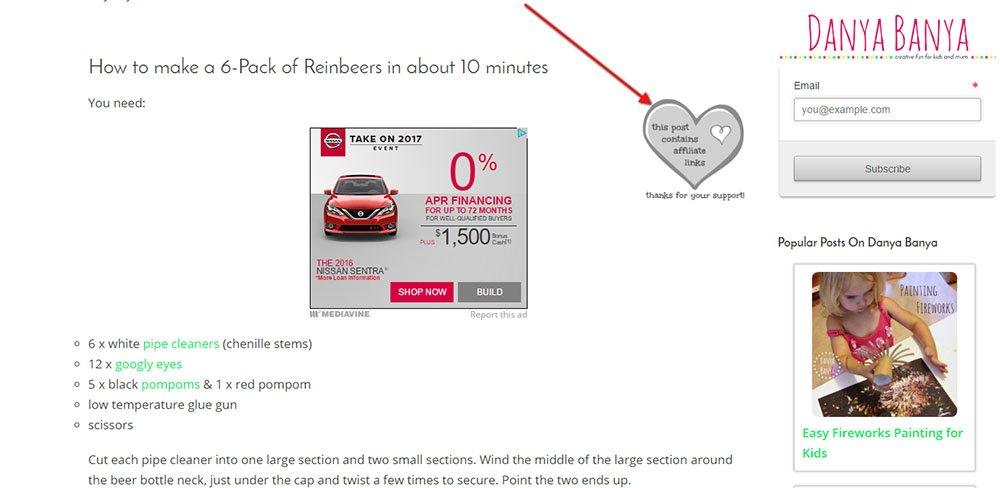
But this disclosure isn't good enough to be the sole disclosure on its own because it isn't informative enough.
Danya Banya fixes this by adding another more thorough disclosure at the bottom of the post:
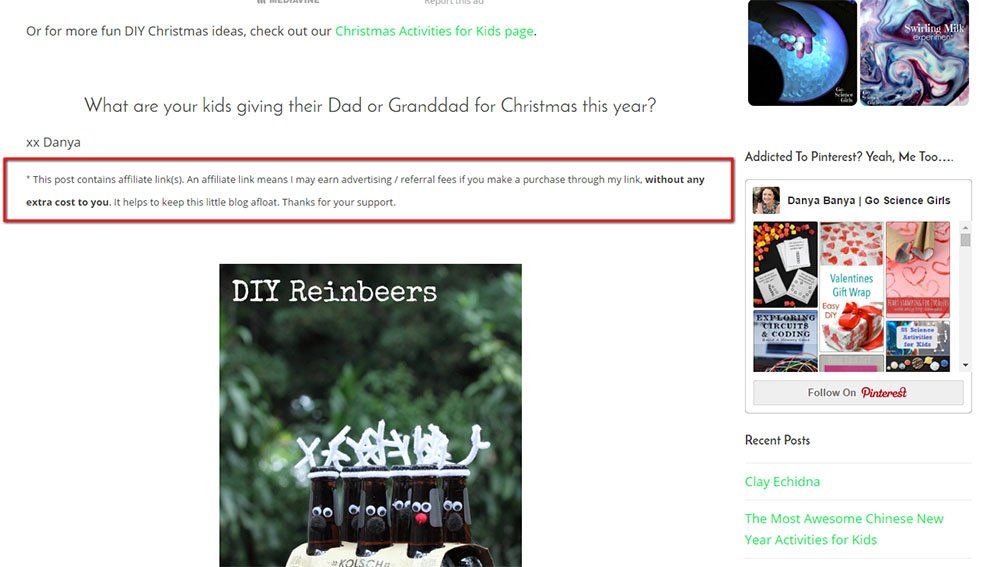
This disclosure placed directly at the end of the post, combined with the small notice placed at the top of the post work together nicely to make sure readers are definitely aware that the author of the post will earn a benefit when purchases are made through the affiliate links used.

The Artful Parent blog takes a similar approach by including a small badge-style notice that affiliate links are included in the post and adding a "thank you for supporting us." text:
![]()
While there isn't an additional disclosure at the bottom of the article like in the Danya Banya example, readers are put on notice of affiliate links with the badge disclosure.
There's also an additional disclosure located in the "About" section of the blog that thoroughly details how compensation plays a role in posts on the Artful Parent blog. Readers are informed that the blog:
"accepts forms of cash advertising, sponsorships, paid insertions or other forms of compensation."
Here's a screenshot of that disclosure from Artful Parent's About page:
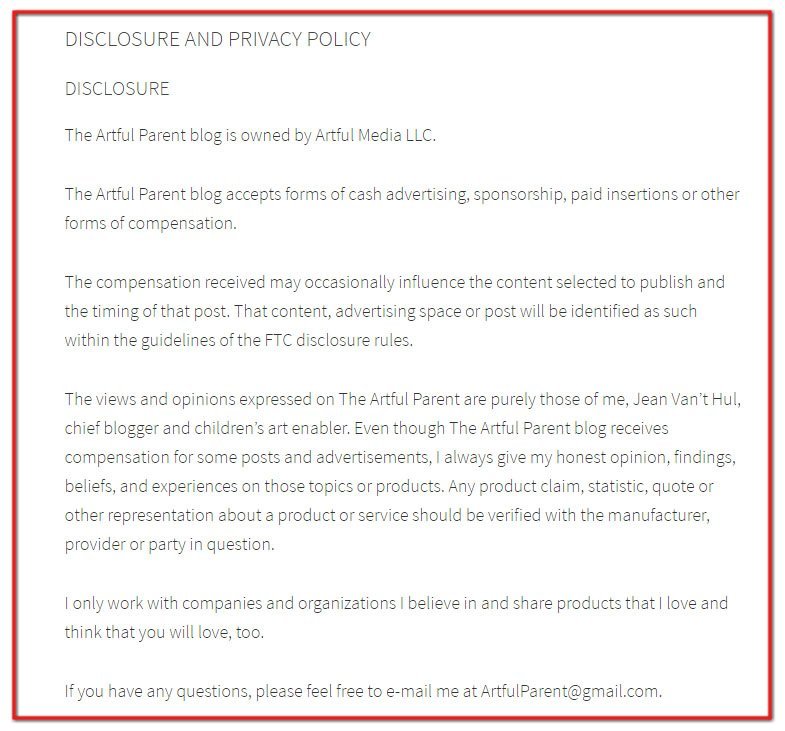
This disclosure would not be adequate enough on its own because it's not conspicuous enough, when it's combined with the badge icon at the beginning of individual articles the two together can potentially create an adequate disclosure.
However, the owner of this blog should consider hyperlinking the badge icon to the "About" disclosure so readers will be able to easily find the disclosure.

A Relaxed Gal discloses her use of affiliate links in posts by including a short disclosure directly following the post title with a link to her full disclosure page.
This is an improvement on how both previous examples presented their disclosures.
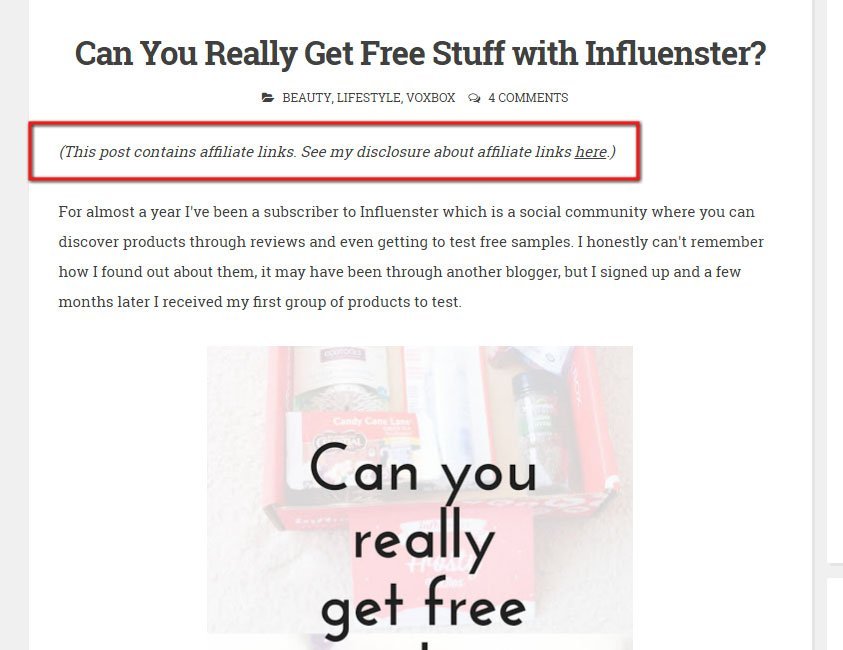
On the disclosure page, readers are told that the A Relaxed Girl blog and owner(s) of the blog accept and receive compensation for posts, advertisements and opinions:
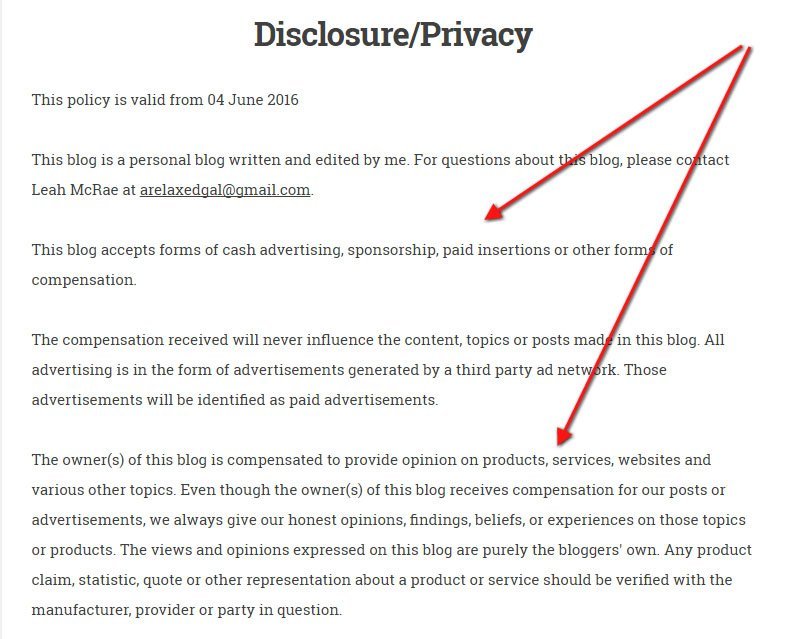
Disclosures for social media
The following disclosures are for Instagram, Twitter, Facebook.
If you're using one of these platforms (or another social media platform) to publish your endorsement, you won't need to - or be able to - create as robust a disclosure as you would in a regular blog post.
Due to the nature of these platforms, posts tend to be shorter, with Twitter limited in characters allowed, and Instagram with the photo as the centerpiece with a short optional caption.
To disclose properly on a social media platform with limited space, you can use hashtags.

An Instagrammer disclosed that the dress she posted a picture of is an advertisement for the dress with a simple hashtag, "ad."
The use of this hashtag lets users know that she's advertising the dress and most likely received some sort of compensation for her post:
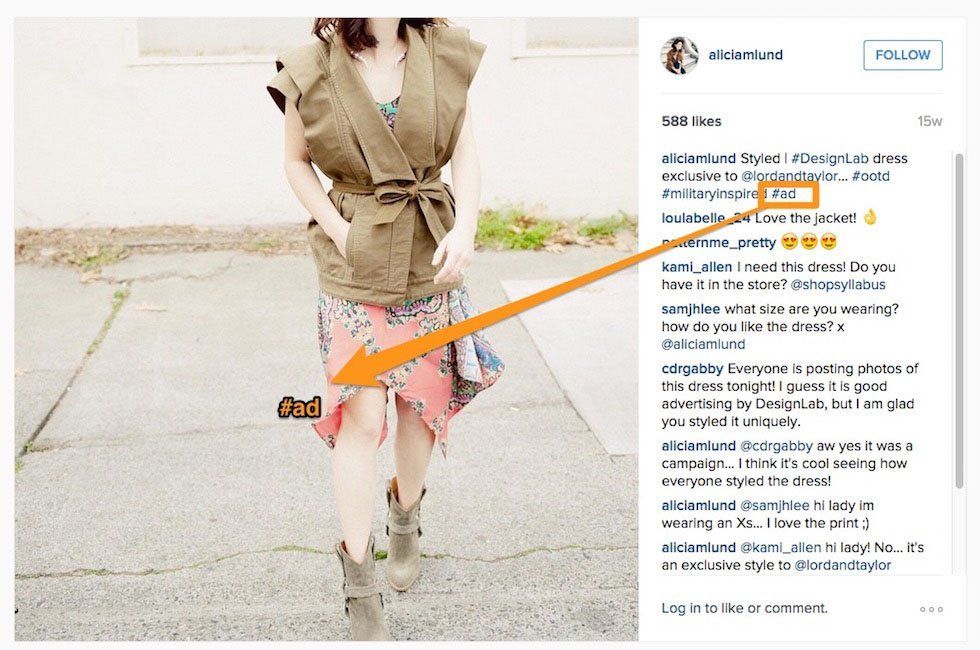
Here's another example of "#ad" in use on Instagram:

Disclosing on Twitter and Facebook can work with the same way when it comes to hashtagging endorsement posts.
![]()
Adding "Ad" at the beginning of a tweet is a really straightforward and simple way of making it undoubtedly clear that your tweet is an ad:

Adding a hashtag at the end of your tweet can also work as a disclosure on your tweet:

The same example can be used for Facebook too.
![]()
Here's how you can make a Facebook post compliant with FTC disclosure requirements by adding hashtags and even a simple one-sentence disclosure:
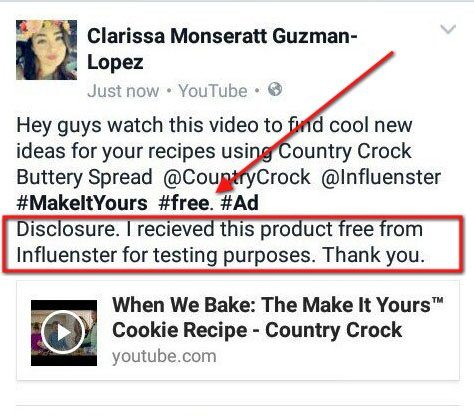
Make sure your disclosure is clearly and conspicuously placed, easily understood by your average consumer, and included on every single endorsement post you make that you stand to profit from in any way.